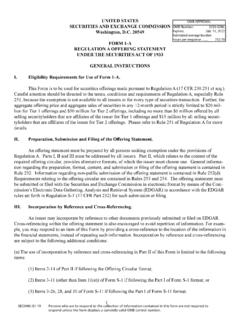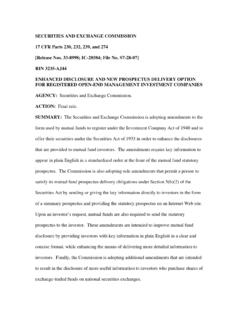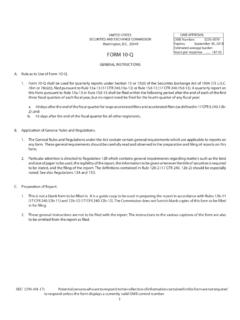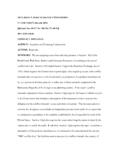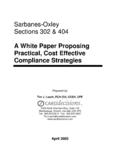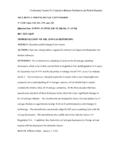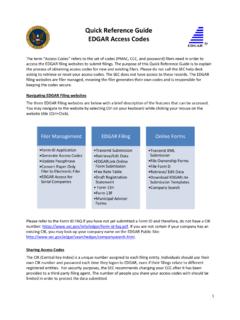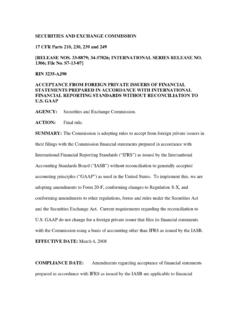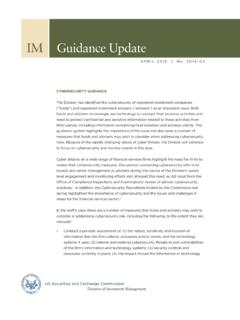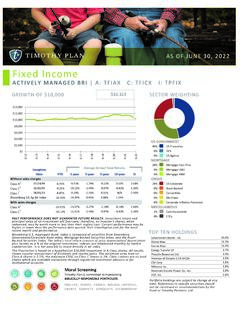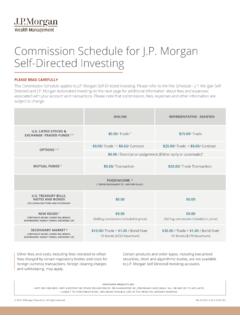Transcription of Investor Bulletin - SEC
1 Investor Bulletin : Exchange-Traded Funds (ETFs)The SEC s Office of Investor Education and Advocacy is issuing this Investor Bulletin to educate investors about exchange-traded funds ( ETFs ). This Investor Bulletin discusses only ETFs that are registered as open-end investment companies or unit investment trusts under the Investment Company Act of 1940 (the 1940 Act ). It does not address other types of exchange-traded products that are not registered under the 1940 Act, such as exchange-traded commodity funds or exchange-traded notes. The following information is general in nature and is not intended to address the specifics of your financial situation. When considering an investment, make sure you understand the particular investment product fully before making an investment decision. What is an ETF? ETFs are a type of exchange-traded investment product that must register with the SEC under the 1940 Act as either an open-end investment company (generally known as funds ) or a unit investment trust.
2 Since the first domestically offered ETF was created in the 1990s, ETFs have become increasingly popular as investment vehicles for both retail and institutional investors. Like mutual funds, ETFs offer investors a way to pool their money in a fund that makes investments in stocks, bonds, or other assets and, in return, to receive an interest in that investment pool. Unlike mutual funds, however, ETF shares are traded on a national stock exchange and at market prices that may or may not be the same as the net asset value ( NAV ) of the shares, that is, the value of the ETF s assets minus its liabilities divided by the number of shares outstanding. Initially, ETFs were all designed to track the performance of specific equity indexes; those types of index-based ETFs continue to be the predominant type of ETF offered and sold in the United States. Newer ETFs, however, also seek to track indexes of fixed- income instruments and foreign securities.
3 In addition, newer ETFs include ETFs that are actively managed - that is, they do not merely seek to passively track an index; instead, they seek to achieve a specified investment objective using an active investment strategy. Certain ETFs can be relatively easy to understand. Other ETFs may have unusual investment objectives or use complex investment strategies that may be more difficult to understand and fit into an Investor s investment portfolio. For example, leveraged ETFs seek to achieve performance equal to a multiple of an index after fees and expenses. These ETFs seek to achieve their investment objective on a daily basis only, potentially making them unsuitable for long-term investors. Investor Assistance (800) 732-0330 to Consider before Investing in ETFs ETFs are not mutual funds. Generally, ETFs combine features of a mutual fund, which can be purchased or redeemed at the end of each trading day at its NAV per share, with the intraday trading feature of a closed-end fund, whose shares trade throughout the trading day at market prices.
4 Intraday trading is described in greater detail below in the section on NAV and Intraday Value. Unlike with mutual fund shares, retail investors can only purchase and sell ETF shares in market transactions. That is, unlike mutual funds, ETFs do not sell individual shares directly to, or redeem their individual shares directly from, retail investors. Instead, ETF sponsors enter into contractual relationships with one or more financial institutions known as Authorized Participants. Authorized Participants typically are large broker-dealers. Only Authorized Participants are permitted to purchase and redeem shares directly from the ETF, and they can do so only in large aggregations or blocks ( , 50,000 ETF shares) commonly called Creation Units. To purchase shares from an ETF, an Authorized Participant assembles and deposits a designated basket of securities and cash with the fund in exchange for which it receives ETF shares.
5 Once the Authorized Participant receives the ETF shares, the Authorized Participant is free to sell the ETF shares in the secondary market to individual investors, institutions, or market makers in the ETF. The redemption process is the reverse of the creation process. An Authorized Participant buys a large block of ETF shares on the open market and delivers those shares to the fund. In return, the Authorized Participant receives a pre-defined basket of individual securities, or the cash equivalent. Other investors purchase and sell ETF shares in market transactions at market prices. An ETF s market price typically will be more or less than the fund s NAV per share. This is because the ETF s market price fluctuates during the trading day as a result of a variety of factors, including the underlying prices of the ETF s assets and the demand for the ETF, while the ETF s NAV is the value of the ETF s assets minus its liabilities, as calculated by the ETF at the end of each business day.
6 An ETF s market price is generally kept close to the ETF s end-of-day NAV because of the arbitrage function inherent to the structure of the ETF. This is described in greater detail below in the section on Arbitrage. Some Differences between ETFs and Mutual Funds Some differences between ETFs and mutual funds include: Because of differences in distribution and often lower transaction costs, total operating expense ratios for ETFs often have been historically less than those for corresponding mutual ETFs will disclose to the public their holdings every day, in addition to the quarterly disclosure required for all mutual can be more tax efficient than mutual funds because ETF shares generally are redeemable in-kind. This means that an ETF may deliver specified portfolio securities to Authorized Participants who are redeeming Creation Units instead of selling portfolio securities to meet redemption demands, which could otherwise result in taxable gains to the ETF.
7 Typically, such taxable gains (if not otherwise offset by the ETF) would be passed through to the retail Investor . Very generally, the federal income tax consequences of investing in ETFs and mutual funds are comparable. However, the SEC does not provide tax advice, and information about the federal income tax consequences to the retail Investor of specific investments is beyond the scope of this Bulletin . For questions regarding the tax implications of investments in specific ETFs and their consequences with respect to your unique situation, please consult your tax adviser. For more information about the federal income tax consequences of registered investment companies generally, please see our publication entitled Investor Assistance (800) 732-0330 Mutual Funds: A Guide for Investors, also available at Regulatory Requirements Regulatory requirements include: As investment companies, ETFs are subject to the regulatory requirements of the federal securities laws as well as certain exemptions that are necessary for ETFs to operate under those laws.
8 Together, the federal securities laws and the relevant exemptions apply requirements that are designed to protect investors from various risks and conflicts associated with investing in example, ETFs, like mutual funds, are subject to statutory limitations on their use of leverage and transactions with affiliates. ETFs also are subject to specific reporting requirements and disclosure obligations relating to investment objectives, risks, expenses, and other information in their registration statements and periodic addition, ETFs are subject to oversight by boards of directors. NAV and Intraday Value An ETF (like a mutual fund) must calculate its NAV (the value of all its assets minus all its liabilities) every business day, which is done typically at the close of the New York Stock Exchange. Approximately every 15 seconds throughout the business day, an ETF s estimated NAV is calculated and distributed through quote services.
9 This estimated NAV (called the IIV for intraday indicative value or IOPV for intraday operative value depending on the exchange on which the ETF lists) is unique to ETFs and is based on the estimated value of the ETF s holdings (minus its liabilities) throughout the trading d a y. You can find an ETF s intraday value on various financial services websites, many of which are familiar to the general public. Often an ETF s intraday value may be found by searching the ETF s ticker symbol followed by .IV ; however this will vary depending on the service used. You should check with the financial service to find out how it makes an ETF s intraday value available. Premiums and Discounts For a variety of reasons, an ETF s market price may trade at a premium or a discount to its underlying value. When an Authorized Participant identifies that an ETF s shares are trading at either a premium or discount to their estimated net asset value, it may engage in trading strategies that are expected to result in the market price of an ETF s shares moving back in line with its underlying value.
10 As noted below in more detail, these actions by Authorized Participants, commonly described as arbitrage opportunities, are designed to keep the market-determined price of an ETF s shares close to its underlying value. The premiums and discounts for specific ETFs may vary over time. information about an ETF s historical premiums and discounts can be found either in the ETF s full prospectus or on its website. Arbitrage Arbitrage is the practice of taking advantage of a price differential between two or more markets. An arbitrage opportunity is inherent in the ETF structure because the ETF s intraday market price fluctuates during the trading day. Due to this fluctuation, the ETF s intraday market price may not equal the ETF s end-of-day NAV. Authorized Participants can arbitrage this difference (and make a profit) because they can trade directly with the ETF at NAV as well as on the market. The expected result of the arbitrage activity is that the market value of the ETF moves back in line with the ETF s NAV per share and investors are able to buy ETF shares on an exchange at a price that is close to the ETF s NAV per share.
